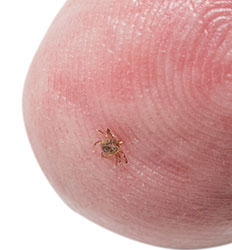Lyme Disease: A Potential, But Unlikely, Problem for Cats
Lyme disease is probably not a concern for cat owners. Although the bacteria that cause Lyme disease is capable of infecting cats, the disease has never been seen in a cat outside of a laboratory setting. However, because Lyme is potentially quite severe and is common among humans and dogs, it is wise to know how the disease is transmitted and what the signs of infection are in your pets.
Named for the Connecticut town where it was first identified in 1975, Lyme disease is a potentially lethal infection. Without prompt treatment, in humans and dogs this bacterial infection can progress to extensive joint damage, deadly cardiac complications, kidney failure, and neurologic dysfunction. Although the disease is most frequently diagnosed in the northeastern U.S., it has been reported in humans in all 48 contiguous states.
According to William Miller Jr., VMD, a professor of Dermatology at Cornell University’s College of Veterinary Medicine, Lyme disease is caused by a spiral-shaped bacterium called Borrelia burgdorferi, which enters an animal’s system via the bite of a young tick (nymph) or an adult female tick. In the northern, midwestern, and southern areas of the nation, infection is transmitted primarily by the black-legged tick, otherwise known as the deer tick. On the West Coast, the bacterium is generally carried by a similar parasite, the Western black-legged tick.
With the arrival of warm weather in the spring, mature ticks—which have been dormant during the colder months-- become active again and resume their quest for blood meals, which, females need for the completion of the life cycle (mating and laying eggs). And as they feed this time, the parasites can infect their new hosts with the dangerous bacteria that they have harbored since their larval stage.
Ticks do not hop like fleas, notes Dr. Miller. Rather, they crawl, perching on the tops of grasses and other vegetation, awaiting the approach of a host, sensing its arrival by the vibrations of a footfall or a sudden rise in temperature caused by the potential victim’s body heat. Immediately after a tick attaches itself to its host, the bacteria begin to reproduce in the area surrounding the bite. Soon afterward, the pathogens move into the bloodstream, and the early signs of Lyme disease will usually become evident within four weeks of infection: fever, lethargy, diminished appetite, and apparently painful stiffness and swelling in the muscles and joints.
Immediate veterinary consultation is warranted, Dr. Miller advises, if any of these signs are observed in your cat during tick season. Lyme disease can be diagnosed through a variety of laboratory tests, including sophisticated blood analyses, with treatment usually involving the use of an antibiotic. Studies in the laboratory setting show that cats that are treated promptly have a very good chance of full recovery. If treatment is delayed, relief may take considerably longer and may require prolonged veterinary care. An infection that remains untreated for an extended period—several weeks or so—can result in irreversible tissue damage.
Although a vaccine is available to protect dogs against Lyme disease, no such vaccine has been developed for cats. However, a cat can be protected to an extent during warm weather by using a cat-safe insect repellent before it goes outdoors. Consult your veterinarian for safe products to use since cats are extremely sensitive to many insecticides, including some all-natural products and products that are marketed for dogs. The cat’s coat should be brushed and thoroughly examined for ticks when it comes back inside. If a tick is spotted, it should be removed, using forceps or tweezers that reach beneath the parasite’s body and grab it close to where the tick is attached to the skin. Studies have shown that infected deer ticks begin transmitting Lyme disease after the tick has been attached for 36-48 hours, so the possibility of Lyme disease transmission can be greatly reduced by examining cats daily and removing ticks within the first 48 hours. Ticks can transmit diseases to humans, so anyone removing a tick should wear gloves, avoid touching the tick with bare hands, and wash their hands after disposing of the tick in a jar of alcohol.
For additional advice and a video on removing ticks, see the American Lyme Disease Foundation’s website.



